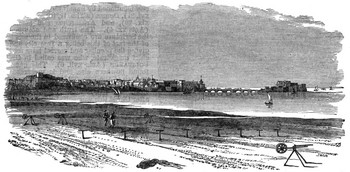|
|

The Life and Successes of Alexander the Great
|
Share This Page
|
|
|
|
|
|
|
Follow This Site

|
 |
|
|
|

|
Part 3: Teaching Foes a Lesson
 Alexander next marched his men along the Mediterranean coast, seizing more coastal cities, this time on the Phoenician coast. One of his main targets was Sidon, the port city that served as the shipyards for the Persian invasions of Egypt and Greece. In 351 B.C., the people of Sidon locked their gates and set fire to the city rather than submit to the Persian leader Artaxerxes. This, of course, made it easer for Alexander to conquer. Alexander next marched his men along the Mediterranean coast, seizing more coastal cities, this time on the Phoenician coast. One of his main targets was Sidon, the port city that served as the shipyards for the Persian invasions of Egypt and Greece. In 351 B.C., the people of Sidon locked their gates and set fire to the city rather than submit to the Persian leader Artaxerxes. This, of course, made it easer for Alexander to conquer.
While the Macedonian king was forcing his way into Sidon and Byblos, Darius was rallying an army 100,000 strong and marching down the Phoenician coast after Alexander. Darius's goals were twofold: intercept Alexander's supply lines and trap the invaders far from home, where they were less likely to put up a fight. Darius got all of what he wanted, except for the last part, the intangible part, which proved to be his undoing in the end. For not the last time, Darius underestimated Alexander.
The Macedonians turned quickly around and marched north. Alexander, kicking himself for assuming that Darius wouldn't come after him, forced his men to march double quick, overnight, for many miles. The two armies met in the Battle of Issus.

It should have been a Persian victory. Darius had more men, who were rested. He had picked the place where he wanted to fight. He was in a defensive position, which Alexander had to attack. In fact, many historians argue, Darius didn't really have to win at all; he just had to avoid losing. If the battle resulted in a standoff, then Alexander would be forced to retreat—toward more Persian forces, coming up from the southeast. But Darius didn't play to tie; he played to win. And this decision cost him dearly.
First of all, Darius deployed his men on a narrow coastal plain, meaning that they would fight in rows, not in a mass formation. Clearly, he did choose the terrain with the idea of using all of his men at once in a mass, hard charge. Secondly, Alexander noticed that Darius had deployed archers near a group of inexperienced young Persian soldiers on the left flank of the main army, where Darius himself stood, in the center. Alexander reasoned that the archers were there because the soldiers couldn't hold the field by themselves. So while the rest of the battlefield raged with hand-to-hand blows, Alexander led his cavalry in a fierce assault on those archers and the experienced infantry they were protecting. Like a carpet, the young Persians folded up and disappeared, with the Macedonian cavalry in hot pursuit. So devastating was the cavalry charge that the entire Persian left flank disappeared, leaving the cavalry with a straight shot at Darius, who quickly led his men in retreat. The emperor, who had counted on a successful defense turning into victory, now found himself in crushing defeat, his armies in full flight, his confidence shattered, the territory he owned rapidly shrinking.
 All of this happened so quickly that Alexander and his men acquired many great spoils from this victory, including the entire royal family—Queen Stateira, Queen Mother Sisygambis, Princess Stateira, and Darius's other children. They remained prisoners of Alexander and his men for a very long time. All of this happened so quickly that Alexander and his men acquired many great spoils from this victory, including the entire royal family—Queen Stateira, Queen Mother Sisygambis, Princess Stateira, and Darius's other children. They remained prisoners of Alexander and his men for a very long time.
Next page > Smashing Success at Issus > Page 1, 2, 3, 4, 5, 6, 7, 8, 9, 10, 11 |
|



 Alexander next marched his men along the Mediterranean coast, seizing more coastal cities, this time on the Phoenician coast. One of his main targets was
Alexander next marched his men along the Mediterranean coast, seizing more coastal cities, this time on the Phoenician coast. One of his main targets was 
 All of this happened so quickly that Alexander and his men acquired many great spoils from this victory, including the entire royal family—Queen Stateira, Queen Mother Sisygambis, Princess Stateira, and Darius's other children. They remained prisoners of Alexander and his men for a very long time.
All of this happened so quickly that Alexander and his men acquired many great spoils from this victory, including the entire royal family—Queen Stateira, Queen Mother Sisygambis, Princess Stateira, and Darius's other children. They remained prisoners of Alexander and his men for a very long time.
